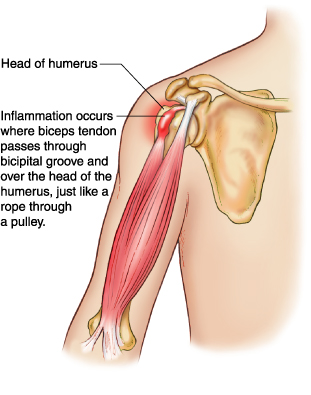
Biceps Tendonitis
Posted By irvinechiro / Date Posted: 2015-06-09
|
What is Bicep Tendonitis?
Bicep tendonitis is a term that describes pain or injury to one of your shoulder's bicep tendons. Biceps tendinopathy is a broad term for many biceps injuries that include: - ruptured biceps tendon (secondary to degeneration or tear), biceps tendonitis, biceps tendinosis and others. Your up-to-date chiropractor will refer to this group of injuries as biceps tendinopathies or the specific injury itself after they have diagnosed the injury thoroughly. Where is your Biceps Tendon? The biceps brachii has two heads: short and long heads. It is predominantly the long-head of biceps that becomes symptomatic. The biceps long head passes over the head of the humerus (ball joint) and attaches to the top of the shoulder socket. The long head of the biceps acts as a shoulder joint stabiliser through depression of the humeral head. The biceps tendon travels through the bicipital groove on the front of the shoulder ball, which is where most inflammation - usually friction related - occurs. If inflammation is the cause you will be diagnosed as either a biceps tendonitis or tenosynovitis. What Causes Biceps Tendinopathy? Biceps tendinopathy is rarely seen in isolation. It is caused by overuse, tendon impingement, shoulder joint instability or trauma. Therefore, it often exists alongside other pathologies of the shoulder, including rotator cuff injuries, labral tears, SLAP lesions and shoulder instability. It is common in sports that involve throwing, swimmers, gymnasts and some contact sports. Occupations that involve overhead shoulder work or heavy lifting are at risk. What are the Symptoms of Biceps Tendinopathy? Bicep tendonitis and tendinopathy sufferers will commonly report: - Pain in the region of the front of the shoulder located over the bicipital groove, occasionally referring down to the elbow. - Overhead activities usually reproduce pain, especially those positions that combine abduction and external rotation eg brushing your hair. - The pain is often aggravated by shoulder flexion, forearm supination, and/or elbow flexion. - Some patients describe muscle weakness and clicking or snapping with shoulder movements. How is Bicep Tendinopathy Diagnosed? Bicipital tendinopathy diagnosis is suspected by your chiropractor based on your symptoms, history and a clinical examination. Ultrasound and MRI are the best investigations to confirm the diagnosis. Bicep Tendinopathy Treatment Treatment is based on the type of tendinopathy but also needs to address the cause of your tendinopathy since this condition is rarely an isolated injury. Biceps tendinosis (non-inflammed degenerative tendon). Due to the non-inflammatory nature, tendinosis is unlikely to respond to (NSAIDs) or cortisone injections. In fact, they may actually be detrimental and delay healing in tendinosis suffers. These require special tendon strengthening exercises that your chiropractor will advise. Pain Relief In the early phase you’ll most likely be unable to fully lift your arm or sleep comfortably. The first aim is to provide you with some active rest from pain-provoking postures and movements. This means that you should stop doing the movement or activity that provoked the shoulder pain in the first place and avoid doing anything that causes pain in your shoulder. You may need to be have your shoulder specially taped to provide pain relief. In some cases it may mean that you need to sleep relatively upright or with pillow support. Your chiropractor will guide you. Ice is a simple and effective modality to reduce your pain and swelling. Please apply for 20-30 minutes each 2 to 4 hours during the initial phase or when you notice that your injury is warm or hot. Your chiropractor will utilise a range of pain relieving techniques including joint mobilisations, massage, acupuncture or dry needling to assist you during this painful phase. Patient Education & Technique Correction It is important that you understand why you have developed bicipital tendinopathy. Your chiropractor will discuss with you what activities and postures are likely to aggravate your condition. They may also need to modify your technique or training/work volume. Range of Motion & Flexibility Your chiropractor will assess your muscle and joint flexibility and prescribe exercises or recommend massage to attain normal range of motion. Improve Joint Stability & Strength Since glenohumeral joint instability is a major cause of bicipital tendinopathy, your chiropractor will need to address your scapulohumeral and scapulothoracic stability and movement function. Exercises may include: - Biceps strengthening - Rotator cuff strengthening. - Scapular stabilisation: strength and rhythm. Neck & Thoracic Posture & Mobility Your neck and upper back are significantly linked to how your shoulder blade is positioned and controlled. In some cases joint stiffness or pain referred from inflammed neck joints can directly alter shoulder pain and function. Your chiropractor is an expert at the assessment and treatment of neck and upper back dysfunction. Ask them for more specific advice. Restore Normal Function: Speed, Load, Power & Proprioception Your Chiropractic treatment will vary depending on the functional requirements that you specifically need for your shoulder. If your shoulder injury has been caused by sport it is usually during high speed activities, which place enormous forces on your body (contractile and non-contractile), or repetitive actions. In order to prevent a recurrence as you return to sport, your chiropractor will guide you with exercises to address these important components of rehabilitation to both prevent a recurrence and improve your sporting performance. Bicep Tendinopathy Prognosis Bicipital tendinopathies are very successfully rehabilitated with a chiropractor-guided rehabilitation program. Even biceps tendon ruptures do not always require surgery and can be rehabilitated to resume excellent shoulder function. In general, the inflammatory versions (tendonitis and tenosynovitis) will respond quicker than the degenerative tendinosis, which already has tendon cell death. It is important to rehabilitate these tendon injuries as well as possible since these are the most likely to rupture in the future. Due to the cause of tendinopathy usually being coexisting rotator cuff
impingement or shoulder instability the timeframe can vary widely. |
Tweet






